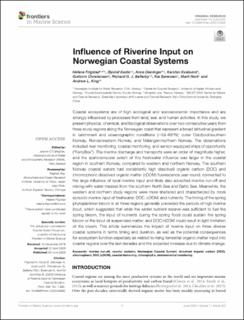| dc.contributor.author | Frigstad, Helene | |
| dc.contributor.author | Kaste, Øyvind | |
| dc.contributor.author | Deininger, Anne | |
| dc.contributor.author | Kvalsund, Karsten | |
| dc.contributor.author | Christensen, Guttorm | |
| dc.contributor.author | Bellerby, Richard | |
| dc.contributor.author | Sørensen, Kai | |
| dc.contributor.author | Norli, Marit | |
| dc.contributor.author | King, Andrew Luke | |
| dc.date.accessioned | 2020-08-18T10:17:34Z | |
| dc.date.available | 2020-08-18T10:17:34Z | |
| dc.date.created | 2020-07-01T13:00:20Z | |
| dc.date.issued | 2020 | |
| dc.identifier.citation | Frigstad, H., Kaste, Ø., Deininger, A., Kvalsund, K., Christensen, G., Bellerby, R., Sørensen, K., Norli, M. & King, A. L. (2020). Influence of Riverine Input on Norwegian Coastal Systems. Frontiers in Marine Science, 7. doi: | en_US |
| dc.identifier.issn | 2296-7745 | |
| dc.identifier.uri | https://hdl.handle.net/11250/2672760 | |
| dc.description.abstract | Coastal ecosystems are of high ecological and socioeconomic importance and are strongly influenced by processes from land, sea, and human activities. In this study, we present physical, chemical, and biological observations over two consecutive years from three study regions along the Norwegian coast that represent a broad latitudinal gradient in catchment and oceanographic conditions (∼59–69°N): outer Oslofjord/southern Norway, Runde/western Norway, and Malangen/northern Norway. The observations included river monitoring, coastal monitoring, and sensor-equipped ships of opportunity (“FerryBox”). The riverine discharge and transports were an order of magnitude higher, and the spatiotemporal extent of this freshwater influence was larger in the coastal region in southern Norway, compared to western and northern Norway. The southern Norway coastal waters had consistently high dissolved organic carbon (DOC) and chromophoric dissolved organic matter (cDOM) fluorescence year-round, connected to the large influence of local riverine input and likely also advected riverine run-off and mixing with water masses from the southern North Sea and Baltic Sea. Meanwhile, the western and northern study regions were more sheltered and characterized by more episodic riverine input of freshwater, DOC, cDOM, and nutrients. The timing of the spring phytoplankton bloom in all three regions generally preceded the periods of high riverine input, which suggested that while the winter nutrient reserve was sufficient to fuel the spring bloom, the input of nutrients during the spring flood could sustain the spring bloom or the input of suspended matter, and DOC/cDOM could result in light limitation of the bloom. This article summarizes the impact of riverine input on three diverse coastal systems in terms timing and duration, as well as the potential consequences for ecosystem function especially as related to rising terrestrial organic matter input into coastal regions over the last decades and the projected increase due to climate change. | en_US |
| dc.language.iso | eng | en_US |
| dc.publisher | Frontiers | en_US |
| dc.rights | Navngivelse 4.0 Internasjonal | * |
| dc.rights.uri | http://creativecommons.org/licenses/by/4.0/deed.no | * |
| dc.title | Influence of Riverine Input on Norwegian Coastal Systems | en_US |
| dc.type | Peer reviewed | en_US |
| dc.type | Journal article | en_US |
| dc.description.version | publishedVersion | en_US |
| dc.rights.holder | © 2020 The Author(s) | en_US |
| dc.subject.nsi | VDP::Landbruks- og Fiskerifag: 900::Fiskerifag: 920 | en_US |
| dc.source.volume | 7 | en_US |
| dc.source.journal | Frontiers in Marine Science | en_US |
| dc.identifier.doi | 10.3389/fmars.2020.00332 | |
| dc.identifier.cristin | 1818090 | |
| cristin.qualitycode | 1 | |

